म्हजें भुरगेपण ते स्टोरीव्हिवरा मेरन...
Posted by Remya Padmadas on September 16, 2016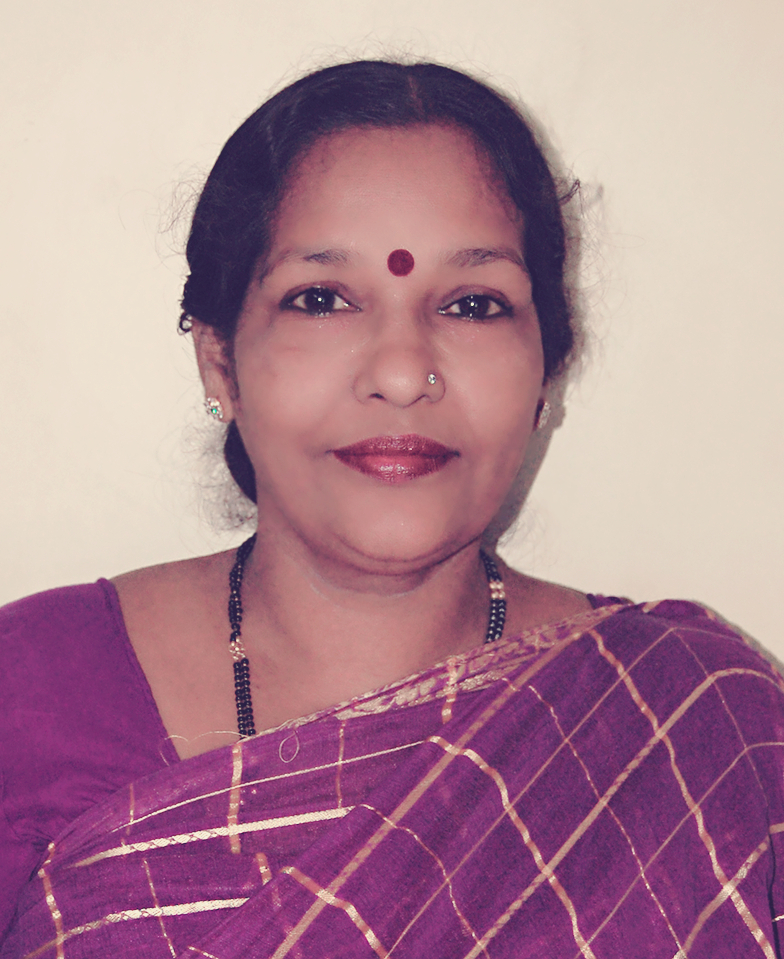
Nayana Adarkar, a graduate in commerce, working as a Sr. SubEditor for Daily Bhaangarbhuin, has published 3 poetry collections, 2 literary essays, a collection of short stories and 16 books for children. Her songs have been included in chilren's audio CDs and her poetry is a part of the Goa Higher Secondary syllabus as well as B.A. syllabus. One of her poems has been included in the Maharashtra Higher Secondary Board syllabus. She has received two awards for children's literature, six awards for her poetry and one for her for story collection. She is also the recipent of the Goa State Yashodamini Award for Literature.
Nayana Adarkar, our Konkani enthusiast lovingly shares with us her many adventures in the World of Stories. She carries us along, right back to the very beginning of her wonderful tryst with poems and stories. We trot alongside as she tells us about how she became and remained the animated, child-like storyteller that she is (Touch Wood:)); how the audience kept changing through the different phases of the growing up years, to marriage, to motherhood - but the stories, they always remained by her side.
We find ourselves eagerly listening in to our favourite Manikantan’s story as she narrates it to a room full of enthusiastic children…and just like her very young audience, we want to hear more and more stories from you, Nayana. Keep weaving magic with the stories, like only you can!
Join us, on this wonderful journey with Nayana…
हांव भुरगेपणांत खूब मस्ते, भरपूर खावप, वाचप , अभिनय करप आनी नाच करप म्हाका आवडटालें. चांदोबा, काणयांची पुस्तकां, पेपर... हाची आवड निर्माण जाली ती म्हजी आजी आनी म्हज्या आज्याची भयण बा कडल्यान. बा मुंबय सावन गोंया येताली. तेन्ना आमी तिका म्हणप, बा, काणी सांग. तिणें मागीर म्हणप, काणी दिल्लीक बसल्या राणी आनी मागीर ती काणी सुरू करताली. म्हजी आवय शिवलिला, भगवतगिता बी वाचून दाखयताली तेंवूय कानार पडटालें.
चवथेंत आसतना एकदां फॅमिली पिकनिकेक गेल्ले कडेन म्हजी पयली कविता जल्माक आयली. मागीर काणयो, नाटकुलीं. आमच्या बाबान वाड्या वयल्या भुरग्यां खातीर शाळा काडिल्ली. ते शाळेंत हांव भुरग्यांक काणयो सांगपाक वतालें. म्हजी वाचनाचे, अभिनयाचे आवडीक सारें मेळटालें.
हांव व्हड जालें खरें पूण म्हज्यांतलें भुरगें तशेंच म्हज्या मनांत उरलें. तें पिकनिकेक, इश्ट-इश्टिणीं मदीं भायर येतालें आनी मस्तेंपणा करतालें. भुरगींय म्हजे कडेन म्हज्या सभावा खातीर ओडटाली. जायत्या जाणांक म्हज्या ह्या प्लस पॉयंटाचो अदमास आयलो. तीं म्हाका काणयो सांगपाक आपोवंक लागलीं. कोंकणी भाशा मंडळ, शाळा, क्लब, ग्रंथालय...
हांव भुरग्यां मदीं वता तेन्ना भुरगें जाता. आनी तेन्नाच म्हाका कळटा भुरग्यांक कितें जाय आसता. नव्यो नव्यो काणयो, तातूंत हांसप आसपाक जाय, नाटक आसपाक जाय, पूण शिकोवणी आसपाक जायना. तूं अशें कर, तशें कर म्हणल्यार भुरग्याक (आनी म्हज्यांतल्या भुरग्याकूय) राग येता. ते परस आडवळणान ती गजाल भुरग्यांच्या मनार घाली, जाल्यार तांकां दुसऱ्यांचे काणयेंतल्यान त्या गजालीचें म्हत्व कळटा. त्या भुरग्याच्यो चुकी आपल्या कडल्यानूय घडटात हें ताच्या लक्षांत येता. आपणें तशें केल्यार कितें जातलें हें नकळटा ताका समजता. आनी तें शाणो जाता.
आतां भुरगीं कसली आसची काणी सांगपा खातीर हाका म्हजे नदरेन अर्थ ना. भुरगें भुरगेंच आसता. हां कांय जाणांची लेव्हल मातशी वेगळी आसूं येता. पूण भुरग्यांक मारप, बडोवप, मरप, दुख्ख जावप ह्यो गजाली आवडनात. चड करून त्या परिस्थितींतल्यान आयिल्ल्या भुरग्यांक. भुरग्यांच्या कलान घेवन तांकां काणयो सांगपाक म्हाका आवडटा. तांचे भशेन नाचून बी काणी सांगल्यार तांकां हांव मागीर तांच्यांतलें एक भुरगें कशें दिसता आनी तिवूंय मनमेकळीं काणयेचो आनंद घेतात. एक थर्ड पर्सन जावन तांचे मदीं काणी सांगूंक गेल्यार भुरगीं तुमकां आपणायनात. हो म्हजो अणभव.
म्हज्या भुरग्यांक काणी सांगता सांगता हांवूय काणयो घडयत गेलें. पेपरांत कामाक आसतना हांव बालसाहित्य विभाग सांबाळटालें. तेन्नाय म्हजे कडसून काणयो घडत गेल्यो. वट्ट 14 काणयांचे संग्रह जाले. आनीकूय काणयो घडटात. बालकविताय करतां. भाशा मंडळान म्हज्यो कविता सी.डी. खातीरूय घेतल्यात. हांव कथा, कविता वांगडा बालसाहित्यूय रचता. त्या बालसाहित्याचो बिंब प्रकाशन, आनी कुडचडें केंद्रांन पुरस्कार दिवन भोवमान केला.
हांव ज्या जाग्यार काणी सांगूंक वता थंय चडश्यो म्हज्यो काणयो सांगतां. आनी केन्ना केन्ना म्हाका आवडटात आनी भुरग्यांक सांगपाक म्हाका बरें पडटात, त्या काणयांतल्यान मनरिजवण जाताच पूण नवें गिन्यान मेळटा, तातूंतल्यान भुरग्यांच्यो भावनाय समजतात. अश्यो काणयो हांव घेता. म्हाका राजीव तांबे हांच्यो काणयो आवडटात. वेगळे तरेच्यो . जनावरांक, वस्तूंक मनशाच्या रुपान पेश करपी. मनिकंठन ही काणीय म्हाका आवडली. आयच्या धांवपळीच्या जगांत भुरगीं फकत अभ्यास, करियराच्या फाटल्यान घुस्पल्यांत. तांच्या मदल्यो भावनांय आमी पालक समजून घेनात. सैमाचीं तरेतरेचीं रुपां तांचे पसून पयस उरतात. तांचे मुखार आसता तें बेगडी टिव्ही, कंप्युटरा वयलें जग. हांवें मणिकंठनाची काणी भुरग्यांक सांगली आनी त्या भुरग्यां मदली मातयेची उदकाची , आजी-आजो हांची ओड पळोवन मन भरून आयलें.
म्हजी इश्टीण रत्नान एकदीस आमनाबायचो फोन येतलो म्हूण सांगलें. आमनाबायन म्हजे मुखार तरातरांच्या काणयांचें भांडार दवरलें. आगळ्यो वेगळ्यो काणयो. वेगवेगळ्या लेखकांच्यो. तांचो अणवाद बी करतना मजा आयली.
Watch Nayana Adarkar in action:
Be the first to comment.
#TranslateAStory campaign: Translation tips and tutorials, answers to FAQs
Posted by Remya Padmadas on April 10, 2020The #TranslateAStory campaign will accelerate the creation of multilingual digital reading material, which will help children continue their learning journey at home, and give them access to books in languages they use and understand.
You can volunteer by translating a storybook (or books) on StoryWeaver. All you have to do is sign in to your StoryWeaver account and use our simple Translate tool - through this you will have access to thousands of delightful storybooks that you can translate
Here are the answers to FAQs, and the links to translation tutorials:
1. Who is eligible to participate?
Anyone who is fluent in two or more languages is urged to participate.
Individuals who are educators or translators, literacy organisations, education advocacy organisations, organisations working at the grassroots with native communities, university / college language departments or tribal departments, organisations working in language revitalization, language organisations, translation organisations, Bhasha Mandals - everyone is welcome to join the campaign.
2. Can we translate more than one book? Can we translate books into more than one language?
Yes! Every translation makes a difference.
3. I have no prior translation experience - is that okay?
It is absolutely fine if you have no prior translation experience - if you are fluent in two or more languages, you are all set!
Refer to our translation resources here, for some useful tips on the nuances of translating children’s storybooks.
4. How do I use the StoryWeaver Translate tool?
Here is a step-by-step guide on using the StoryWeaver Translate tool. You can check out our video tutorial here.
5. StoryWeaver doesn't have my language listed. Can I still participate?
Do write to us at [email protected]- we shall add your language to StoryWeaver, provided there is a Unicode compliant font for your language.
6. Is there prize money to be won?
This is not a contest, rather an invitation to volunteer our time and language expertise. There is no prize money.
7. How will I get credited for the book(s) I translate?
Once you create your own, individual account on StoryWeaver, this ensures that you receive an attribution for your translation.
8. There are 4 reading levels - what does this mean? Does it make a difference to the translation?
It is always good to keep the reading level of the child in mind while translating a storybook. Use the ‘filter by level’ option on the Translate page to browse and choose a book.
- Level 1: Storybooks for beginner readers. These books usually have short, simple sentences and don't have more than 1-2 sentences per page.
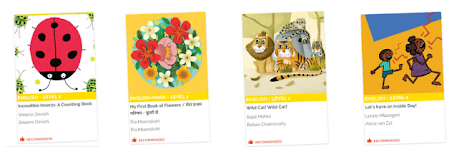
- Level 2: Storybooks for those who are learning to read, based on simple concepts. The books have short sentences and there are not more than 3-4 sentences per page. However you will find that some big but common words are used in these books.
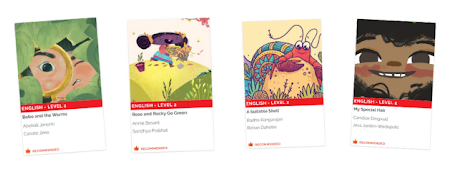
-
Level 3: Storybooks for independent readers which have popular topics with well sketched out characters. The books have longer sentences, paragraphs and complex words.
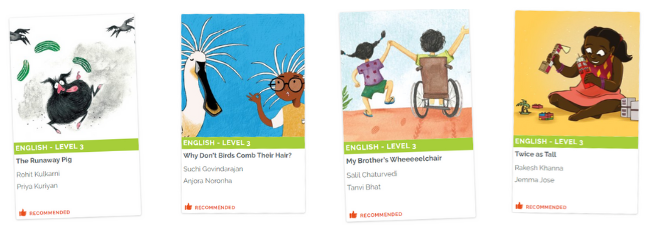
-
Level 4: These stories are meant for those who can read proficiently and have nuanced storylines. The books have complex words, longer sentences and paragraphs. These stories sometimes contain language play like idioms, metaphors, similes, etc. Also words from other languages are introduced.
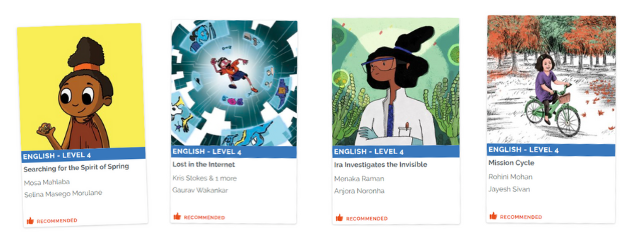
We hope this helps!
Looking for some inspiration for which storybooks to translate? Start here.
By submitting your translation to StoryWeaver, you are agreeing to a CC-BY 4.0 license being applied to it. Terms and conditions apply. For more read here.
For any other queries, do write to us at [email protected]
அ आ ಇ
Posted by Remya Padmadas on May 02, 2016StoryWeaver has been blown away by the amazing work being shared on Instagram @36daysoftype.
"36days is a yearly open call inviting designers, illustrators and visual artists to share their view on the letters and numbers from our alphabet."
We noticed that most people were taking part in English till a colleague pointed us to @HindiRinny who was doing fabulous things in the Devanagari script. Check out this awesome video:
We thought it would be amazing if we (and that means you too!) could start contributing an alphabet in a language we're fluent in, designed creatively.
Take a look at what our Content Manager, Yamini Vijayan shared: മ for Manjadikuru.
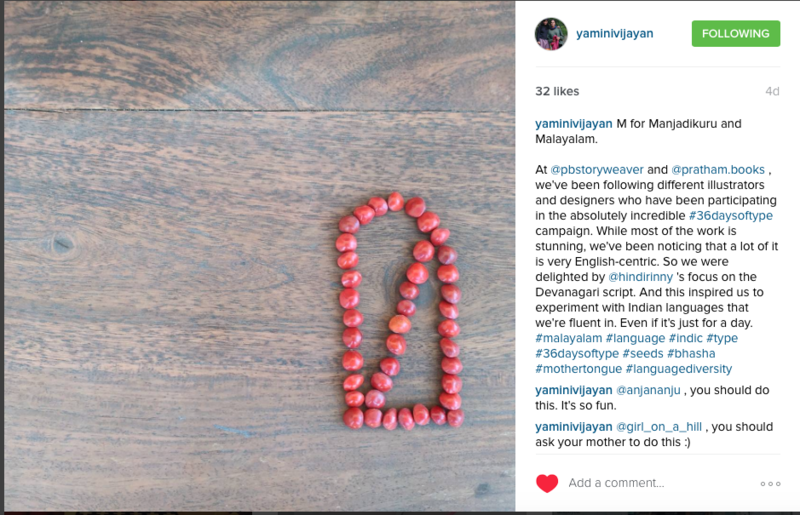
You could share these from your own Twitter, Instagram or Facebook handles and tag us @PBStoryWeaver or email a picture at [email protected].
Looking forward to some amazing, creative Indic language letters!
Be the first to comment.